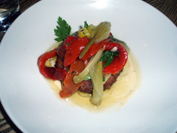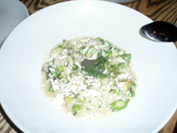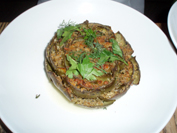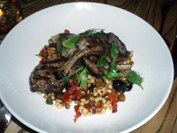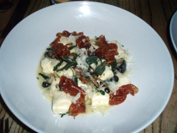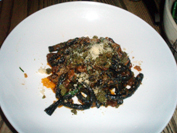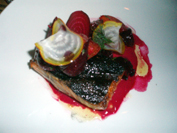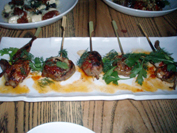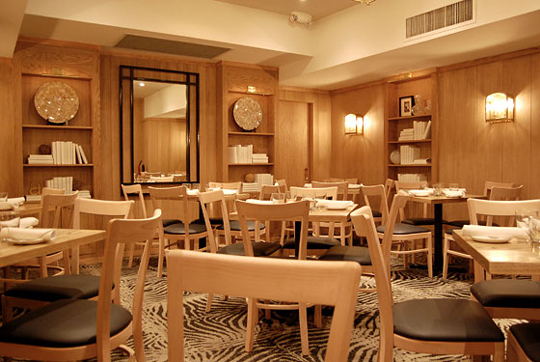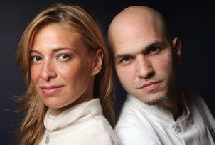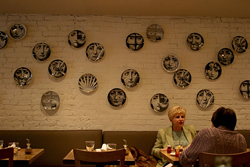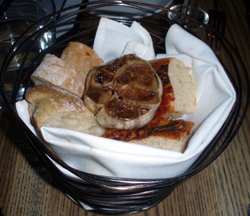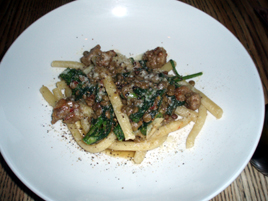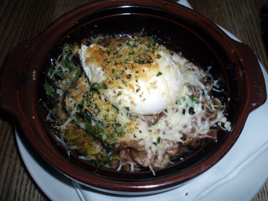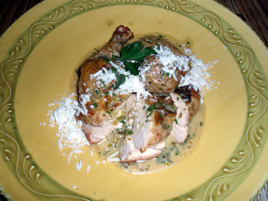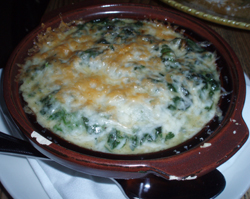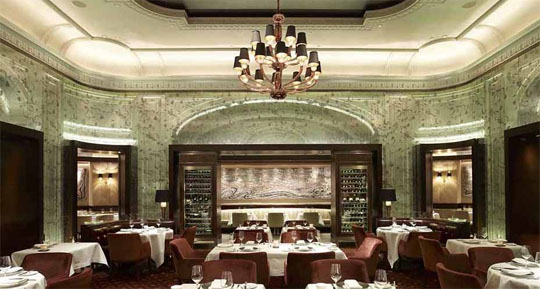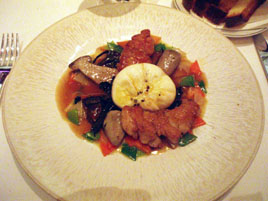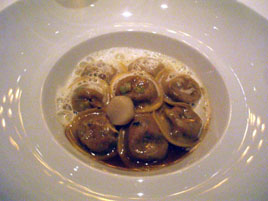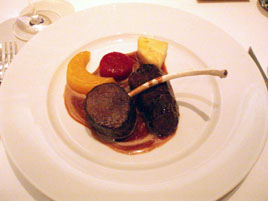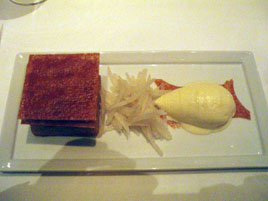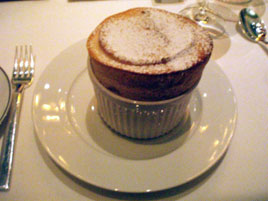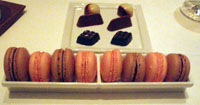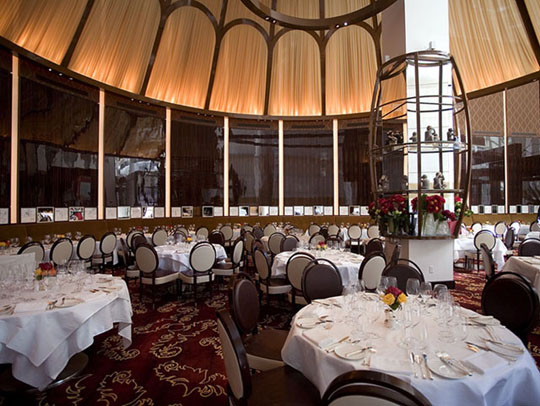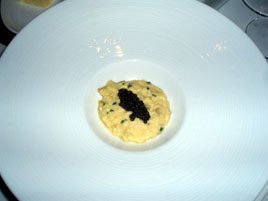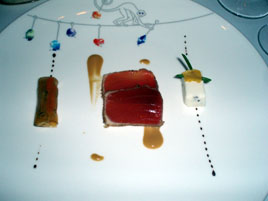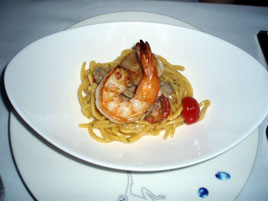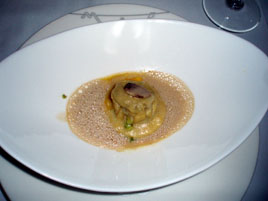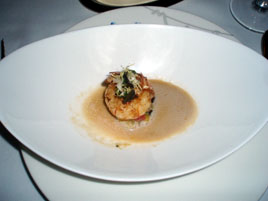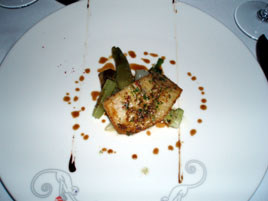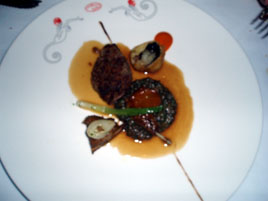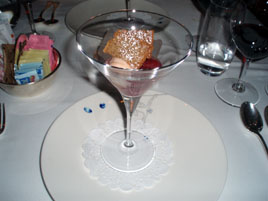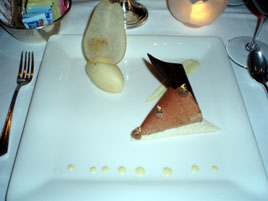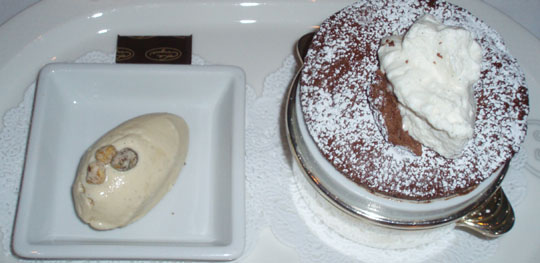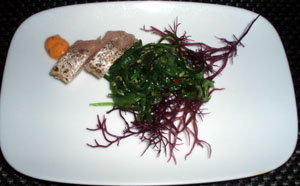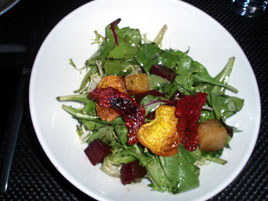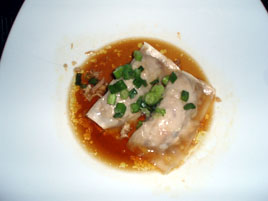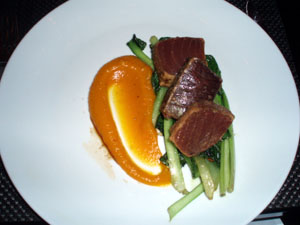
Note: L’Atelier de Joël Robuchon closed at the end of June 2012. A conflict with the union was partly to blame. It is expected to re-open in March 2015 at Brookfield Place in Battery Park City. This will be a stiff test of the viability of fine dining downtown.
*
The French Gault Millau hailed Joël Robuchon as Chef of the Century—the last one, that is.
 So when Robuchon’s L’Atelier (the name means “workshop”) arrived in town, what did the city’s two principal critics say? They complained the place was too casual. New York’s Adam Platt said that he would award four stars for the food, negative one for the ambiance, for a total of three, the same total Frank Bruni awarded.
So when Robuchon’s L’Atelier (the name means “workshop”) arrived in town, what did the city’s two principal critics say? They complained the place was too casual. New York’s Adam Platt said that he would award four stars for the food, negative one for the ambiance, for a total of three, the same total Frank Bruni awarded.
Let us recall that Platt awarded four stars to Momofuku Ko without subtracting a star for ambiance, even though the experience at Momofuku Ko is in every respect inferior to L’Atelier de Joël Robuchon.
Let us also recall that after Frank Bruni reviewed this restaurant in October 2006, it took another sixteen months for him to find another new restaurant worthy of three stars. When he finally did, what was it? Why, Dovetail, another restaurant in every respect inferior by an order of magnitude to L’Atelier de Joël Robuchon.
After I returned home from my visit here, I immediately resolved to downgrade Momofuku Ko, a very good restaurant to which I had, nevertheless, erroneously awarded 3½ stars. One needs to be reminded occasionally of what the word “extraordinary” really means, lest it be confused with that which is merely “excellent.”
 Food isn’t the only thing that’s extraordinary at L’Atelier. So are the prices. Little tasting plates range from $17–38 (not counting the caviar dish), and you’ll need about four of these to make a satisfactory meal. Appetizers range from $16–44, entrées from $37–46. Desserts are $17 apiece. The nine-course tasting menu is $190, making it the city’s third-most expensive after Masa and Per Se. The wine list, as you’d expect, carries prices to match: I saw no reds below $70.
Food isn’t the only thing that’s extraordinary at L’Atelier. So are the prices. Little tasting plates range from $17–38 (not counting the caviar dish), and you’ll need about four of these to make a satisfactory meal. Appetizers range from $16–44, entrées from $37–46. Desserts are $17 apiece. The nine-course tasting menu is $190, making it the city’s third-most expensive after Masa and Per Se. The wine list, as you’d expect, carries prices to match: I saw no reds below $70.
But those who dine at this class of restaurant are already reconciled to dropping a sum of money. Momofuku Ko doesn’t become better than L’Atelier, just because David Chang has found a way to serve extremely good (though not extraordinary) cuisine at a price for the masses.
The two restaurants are comparable in many ways, as both feature counter dining, though the counter at L’Atelier is considerably more spacious and comfortable. L’Atelier also has twenty-six table seats, and I suspect much of the experience is diluted if you sit there, as it would be at any good sushi restaurant.
 But continuing the comparison, it must be noted that L’Atelier has considerably more kitchen space than Momofuku Ko. With about 36 savory courses and 8 desserts, you could dine at L’Atelier a good half-dozen times without duplicating a selection. At Momofuku Ko, you will have come fairly close to exhausting the possibilities after just a couple of dinners.
But continuing the comparison, it must be noted that L’Atelier has considerably more kitchen space than Momofuku Ko. With about 36 savory courses and 8 desserts, you could dine at L’Atelier a good half-dozen times without duplicating a selection. At Momofuku Ko, you will have come fairly close to exhausting the possibilities after just a couple of dinners.
At L’Atelier, the level of precision is something remarkable to behold. A chef actually uses tweezers to place chives on a plate. A couple of times, we were astounded, not merely at how good something tasted, but at how it could have existed at all. Robuchon is not just a chef, but a magician too.
Although Robuchon has seventeen Michelin stars (currently tops in the world), and something like eighteen restaurants, he is not a totally absentee chef. He recently spent a week in New York. Food & Wine reported that he was actually cooking. (We asked the staff about this, and they conceded he does not spend the whole evening in the kitchen, and that he does a good deal of schmoozing, too.)
 To dine at L’Atelier, you have to put up with a slightly overwhelming menu. The items are in three categories (tasting plates, appetizers, entrées). Assuming you give the tasting menu a pass (which we did), how much constitutes a meal? The server advised that each “tasting plate” is generally about half the size of a conventional appetizer, but this isn’t strictly true when you consider the richness of the food. (My girlfriend wondered how many tons of butter they go through in a day.)
To dine at L’Atelier, you have to put up with a slightly overwhelming menu. The items are in three categories (tasting plates, appetizers, entrées). Assuming you give the tasting menu a pass (which we did), how much constitutes a meal? The server advised that each “tasting plate” is generally about half the size of a conventional appetizer, but this isn’t strictly true when you consider the richness of the food. (My girlfriend wondered how many tons of butter they go through in a day.)
We decided to order two tasting plates and one entrée apiece, and to swap plates in between courses, which allowed us to try six things between us.


Bread service; Amuse-bouche
The bread service was lovely, though I would have preferred softer butter to go with it. The amuse-bouche was a delightful little foie gras mousse with a port reduction and parmesan foam.


Le Saumon (left); L’Ognion Nouveau (right)
The dishes here have deceptively simple names. I started with Le Saumon ($25). On the right side of the plate are two strips of thinly cut smoked salmon. On the left is a tangle of shredded crisp potato, but inside is a lightly poached egg. How they got the potato to completely surround the egg without damaging it is a mystery. You cut into the potato, and the egg yolk spills out: a deconstructed egg, salmon and potato omelet.
L’Ognion Nouveau ($24), an onion tart, was less mysterious, but every bit as accomplished in its preparation.


Le Ris de Veau (left); Les Burgers (right)
Le Ris de Veau ($29) offered two succulent sweetbreads, but equally delightful was the spring of stuffed romaine lettuce—stuffed with what? We were not sure, but it was astonishing.
But that was nothing compared to Les Burgers ($39), two small double-decker burgers with beef, foie gras and caramelized bell peppers, with hand-cut fries and Robuchon’s take on homemade ketchup. In another restaurant, these tiny burgers would be called sliders, but they put to shame every other version I’ve tried. The beef and foie gras melt together into one potent flavor package. Of the fries, my girlfriend said, “These are what I want before I die.”


La Caille (left); Le Tete de Veau (right)
The entrées didn’t rock our world quite as much as the tasting plates did. La Caille ($45), or quail, is one of Robuchon’s signature dishes, and I suspect anyone that loves the bird would love this bird. He stuffs the breast with foie gras, and caramelizes the outside. There are two little wings, two little breasts, and a potato purée on the side. I thought the dish disappeared awfully quickly for something that costs $45, and it was a lot of work to pull off what little meat a quail wing had to offer. But ’tis ever thus with quail. (The menu also offers a tasting portion of this dish, at $30.)
Le Tete de Veau ($42) is a remarkable preparation of a veal’s head, with bits of the cheek, tongue, and other unmentionables pounded thin, layered, rolled in a layer of fat, and cooked till crisp. We both thought that the fat overpowered the dish, but we didn’t have a basis of comparison for evaluating this classic.



Cheese plate; Cappuccino; Petits-fours
In lieu of dessert, we chose the cheese plate ($28), with four wonderful choices: from left to right, Hoch Ybrig, Emissaire de Notre Dame, Camembert Chatelain, and Bleu d’Auvergne. (The staff kindly produced a handwritten list when we asked for it.)
The unusually large cappuccino ($12) seemed worthy of a photo too, as well as two precious chocolate petits-fours that came on their own little pedestal.
The service throughout was first-class, notwithstanding the inherent informality of the counter setting. (Even the runners wear white gloves.) Our server had some mannerisms that were a bit irritating. Whatever we ordered seemed coincidentally to be her favorite item on the menu. A couple of times, she punctuated our dinner with “Good job!”, as if we were earning merit badges.
 The restaurant is located in a corner of the Four Seasons hotel, but there is little separation between the dining room and the hotel bar just outside it. Both New York’s Platt and the Times’ Frank Bruni complained that the bar’s hubbub interfered with the quiet seclusion that such a meal ostensibly calls for. That may well have been true in the early days, when foodies were tripping over each other to try New York’s latest new thing. It was not an issue at any time during our two-hour meal on a Saturday evening. The restaurant was about two-thirds full.
The restaurant is located in a corner of the Four Seasons hotel, but there is little separation between the dining room and the hotel bar just outside it. Both New York’s Platt and the Times’ Frank Bruni complained that the bar’s hubbub interfered with the quiet seclusion that such a meal ostensibly calls for. That may well have been true in the early days, when foodies were tripping over each other to try New York’s latest new thing. It was not an issue at any time during our two-hour meal on a Saturday evening. The restaurant was about two-thirds full.
With its stratospheric prices, L’Atelier de Joël Robuchon does not allow you to get out cheaply. Dinner for two came to $475, including tax and tip. At our income level, it cannot be anything more than an “occasion place,” visited occasionally. But assuming you take the plunge, you are almost certain to be treated to a level of cuisine few New York restaurants can match.
L’Atelier de Joël Robuchon (57 E. 57th Street between Park & Madison Avenues, in the Four Seasons Hotel, East Midtown)
Cuisine: Modern French, with luxury ingredients, impeccably prepared
Service: The white glove treatment, literally and figuratively
Ambiance: As elegant as counter service could ever be
Overall: ★★★★
 Sunday, November 2, 2008 at 09:00AM
Sunday, November 2, 2008 at 09:00AM 










